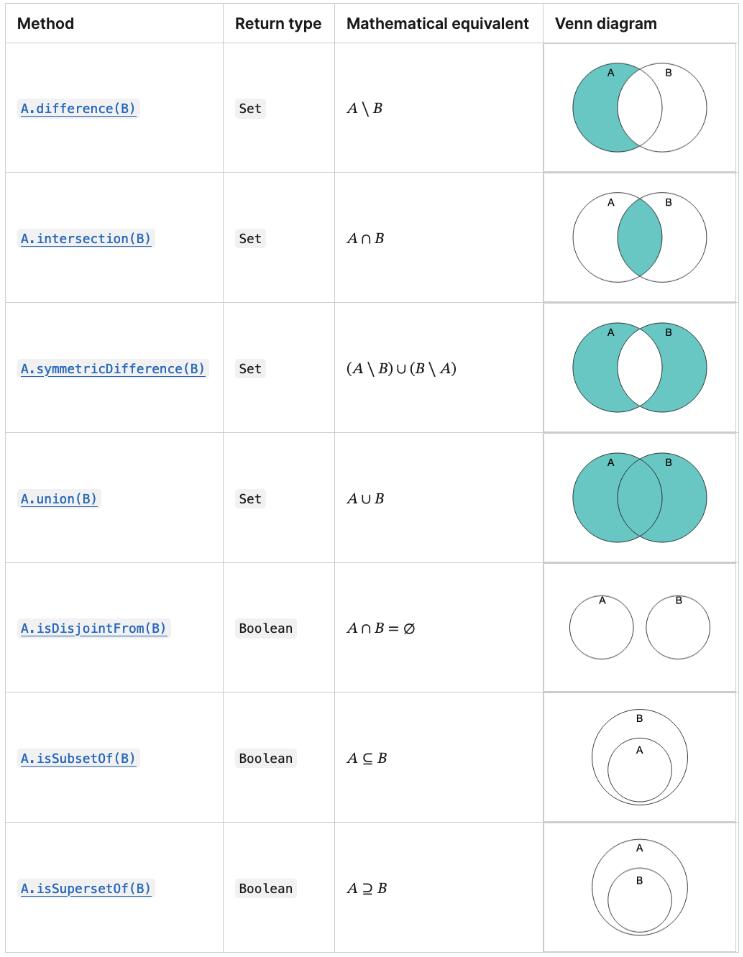

JavaScript 新增 7 个方法,很实用!
source link: https://www.fly63.com/article/detial/12649
Go to the source link to view the article. You can view the picture content, updated content and better typesetting reading experience. If the link is broken, please click the button below to view the snapshot at that time.
Chrome 浏览器将在下一个版本(Chrome 122)支持 7 个全新的 JavaScript 方法,以增强 Set 对象的功能。
这些方法都是由 proposal-set-methods 提案提出的,目前该提案已经进入第三阶段,api 已经基本稳定。预计在 2024 年,这些方法将被纳入 ECMAScript 2024 规范中。这些方法包括:

下面先来看看 JavaScript 中的 Set 是什么,如何使用,又有何用处!
Set 基础
在 JavaScript 中,Set 是一种集合数据结构,它类似于数组,但成员的值都是唯一的,没有重复的值。Set 中的元素可以是任何类型,包括原始类型和对象引用。
Set 对象有多个方法可以操作集合。这些方法包括:
1、add(value): 添加某个值,并返回集合本身。如果该值已经存在,则不会再次添加。
let mySet = new Set();
mySet.add(1); // 添加元素1
console.log(mySet.has(1)); // 输出:true
mySet.add(1); // 再次添加元素1,但不会添加
console.log(mySet.size); // 输出:12、delete(value): 删除某个值,并返回一个布尔值,表示是否成功删除。
let mySet = new Set();
mySet.add(1); // 添加元素1
console.log(mySet.has(1)); // 输出:true
mySet.delete(1); // 删除元素1
console.log(mySet.has(1)); // 输出:false3、has(value): 返回一个布尔值,表示某个值是否存在于集合中。
let mySet = new Set();
mySet.add(1); // 添加元素1
console.log(mySet.has(1)); // 输出:true
console.log(mySet.has(2)); // 输出:false4、clear(): 清除所有元素,并返回集合本身。
let mySet = new Set();
mySet.add(1); // 添加元素1
mySet.clear(); // 清空集合
console.log(mySet.has(1)); // 输出:false5、size: 返回集合中元素的数量。
let mySet = new Set();
mySet.add(1); // 添加元素1
console.log(mySet.size); // 输出:1
mySet.add(2); // 添加元素2
console.log(mySet.size); // 输出:2Set 有很多实用的场景:
去重:Set对象最直接的应用就是去重。由于Set中的元素是唯一的,因此可以用来去除数组中的重复元素。
let array = [1, 2, 3, 3, 2, 1];
let set = new Set(array);
console.log(Array.from(set)); // 输出: [1, 2, 3]
集合运算:由于Set对象支持添加、删除和检查成员的方法,因此可以用来执行集合运算,如并集、交集和差集等。
const arr1 = [1, 2, 3];
const arr2 = [3, 4, 5];
const set1 = new Set(arr1);
const set2 = new Set(arr2);
// 求交集
const intersection = Array.from(set1).filter(item => set2.has(item)); // [3]
// 求并集
const union = Array.from(new Set([...arr1, ...arr2])); // [1, 2, 3, 4, 5]
// 求差集
const difference = Array.from(set1).filter(item => !set2.has(item)); // [1, 2]
存储不重复的数据:由于 Set 中的元素是唯一的,因此可以利用 Set 对象来存储不重复的数据,例如:
const mySet = new Set();
mySet.add(1);
mySet.add(2);
mySet.add(3);
mySet.add(1); // 添加重复元素,不会生效
console.log(mySet); // Set {1, 2, 3}
缓存:利用Set的唯一性,可以快速检查一个值是否已经被缓存。这通常用于函数的结果缓存,避免重复计算。例如:
let cache = new Set();
function expensiveFunction(input) {
if (cache.has(input)) { // 如果结果已经在缓存中,直接返回结果,避免重复计算。
return cache.get(input); // 使用get方法从set中获取值。
} else { // 如果结果不在缓存中,计算结果并存入缓存。
let result = computeExpensiveFunction(input); // 假设computeExpensiveFunction是实际计算函数。
cache.add(input); // 将结果存入缓存。注意,这里使用add方法添加值到set中。
return result; // 返回计算结果。
}
}
代码优化:在某些情况下,使用Set代替数组可以提升代码的效率。例如,使用Set的has方法比使用数组的indexOf方法更快。
全新 Set 方法
上面提到,由于 Set 对象支持添加、删除和检查成员的方法,因此我们可以用来执行集合运算,如并集、交集和差集等。例如:
const arr1 = [1, 2, 3];
const arr2 = [3, 4, 5];
const set1 = new Set(arr1);
const set2 = new Set(arr2);
// 求交集
const intersection = Array.from(set1).filter(item => set2.has(item)); // [3]
// 求并集
const union = Array.from(new Set([...arr1, ...arr2])); // [1, 2, 3, 4, 5]
// 求差集
const difference = Array.from(set1).filter(item => !set2.has(item)); // [1, 2]
可以看到,为了执行集合运算,如交集、差集、并集等,通常需要借助其他方法,如 filter,这使得代码变得复杂且冗余。为了简化这一过程,proposal-set-methods 提案应运而生。该提案为 Set 对象新增了七个实用的方法,使得我们能够直接对集合进行各种计算。通过这些新方法,我们不再需要组合多个方法来完成集合运算,从而简化了代码并提高了可读性。
Set.prototype.intersection(other)
Set.prototype.union(other)
Set.prototype.difference(other)
Set.prototype.symmetricDifference(other)
Set.prototype.isSubsetOf(other)
Set.prototype.isSupersetOf(other)
Set.prototype.isDisjointFrom(other)
下面就来分别看一下这些方法。
注意:这些方法是支持链式调用的。
intersection
intersection 方法用于求两个 Set 对象的交集,返回一个新的 Set 对象,包含两个 Set 对象中都存在的元素。
const mobile = new Set(['javascript','java','swift', 'dart']);
const backend = new Set(['php','python','javascript','java']);
const frontend = new Set(['javascript','dart']);
mobile.intersection(backend);
// Set { javascript, java }
mobile.intersection(backend).intersection(frontend);
// Set { javascript }
union
union 方法用于求两个 Set 对象的并集,返回一个新的 Set 对象,包含两个 Set 对象中所有的元素。
const creation = new Set(['coding', 'writing', 'painting']);
const joy = new Set(['crying', 'laughing', 'coding']);
creation.union(joy);
// Set {'coding','crying','writing','laughing','painting'}
difference
difference 方法用于求两个 Set 对象的差集,返回一个新的 Set 对象,包含存在于当前 Set 对象中,但不存在于参数 Set 对象中的元素。
const joy = new Set(['crying', 'laughing','coding']);
const pain = new Set(['crying','screaming','coding']);
joy.difference(pain);
// Set {'laughing'}
symmetricDifference
symmetricDifference 方法用于求两个 Set 对象的对称差集,返回一个新的 Set 对象,包含存在于任意一个 Set 对象中,但不存在于两个 Set 对象中的元素。例如:
const joy = new Set(['crying',"laughing",'coding']);
const pain = new Set(['crying','screaming','coding']);
joy.symmetricDifference(pain);
// Set {'laughing', 'screaming'}
isSubsetOf
isSubsetOf 方法用于判断当前 Set 对象是否为另一个 Set 对象的子集,返回一个布尔值。例如:
const set1 = new Set([1, 2, 3]);
const set2 = new Set([2, 3, 4]);
set1.isSubsetOf(set2); // false
set2.isSubsetOf(set1); // false
const set3 = new Set([2, 3]);
set3.isSubsetOf(set1); // true
set3.isSubsetOf(set2); // true
isSupersetOf
isSupersetOf 方法用于判断当前 Set 对象是否为另一个 Set 对象的超集,返回一个布尔值。例如:
const set1 = new Set([1, 2, 3]);
const set2 = new Set([2, 3, 4]);
console.log(set1.isSupersetOf(set2)); // false
console.log(set2.isSupersetOf(set1)); // false
const set3 = new Set([2, 3]);
set1.isSupersetOf(set3); // true
set2.isSupersetOf(set3); // true
isDisjointFrom
isDisjointFrom 方法用于判断当前 Set 对象和另一个 Set 对象是否没有交集,返回一个布尔值。
const set1 = new Set([1, 2, 3]);
const set2 = new Set([4, 5, 6]);
set1.isDisjointFrom(set2); // true
const set3 = new Set([3, 4, 5]);
set1.isDisjointFrom(set3); // false
set2.isDisjointFrom(set3); // false有了这些方法,再也不用编写复杂的代码去实现这些方法,也不用借助第三方库(例如 lodash)来实现集合计算了。
来源:前端充电宝,作者:CUGGZ
Recommend
About Joyk
Aggregate valuable and interesting links.
Joyk means Joy of geeK